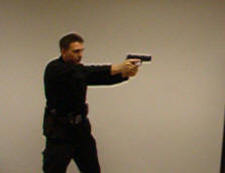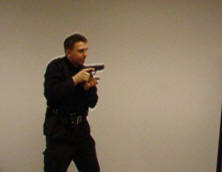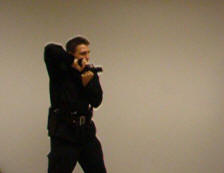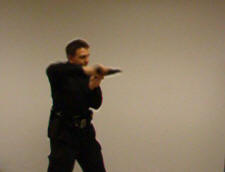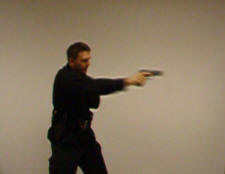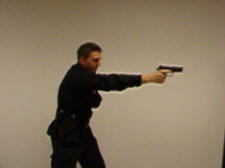Training Tips
All training information, tips, or suggestions presented here are provided for informational purposes only. Neither Saber Group, Inc., Saber Press, nor the authors of any of these materials is responsible for the use or misuse of any information contained on this website. Firearms training is a dangerous activity that can lead to serious injury or death if not properly and safely performed. All training must be conducted at approved ranges and under competent supervision. Proper protective equipment (eye protection, hearing protection, baseball cap and body armor) should always be worn when training.
The Tap, Invert, Rack, Ready (TIRR*) Stoppage Clearing Drill (How to) (*Pronounced "Tear clear!" for training purposes)
|
Video Demonstrations
|
|
FIRST, from the firing position (above), having experienced a failure to fire...
1. TAP: Bring the pistol back toward your chest as you tap up sharply on the magazine with the non-dominant hand to ensure the magazine is seated and locked.
2. INVERT: Keep the weapon back toward the chest as you completely invert the pistol. The non-dominant hand's forefinger and thumb simultaneously establish a secure "slingshot" type grip on the rear of the slide. You must rotate the pistol in-board toward the center-line of your body as shown, not outboard, as some people tend to do.
3 & 4. RACK: The dominant hand, trigger finger along the frame, is used to aggressively punch the weapon forward (as opposed to the non-dominant hand racking the slide back) toward the threat. This action literally pulls the slide from the grasp of the non-dominant hand as the slide reaches maximum retraction position (shown above). The sharp action of this movement should cause any loose shell casings or misfed rounds to be dislodged. Gravity will then cause them to fall clear of the weapon through the ejection port. As the pistol is driven forward, the dominant hand simultaneously corkscrews outboard (as shown above right), righting the pistol and bringing it into alignment with the threat as show in the photograph below.
|
TIRR CLEAR DRILL: Why?This variation of the immediate action drill has been adapted for two simple reasons: it is more efficient, and it works better when the operator performing it is engaged in stressful, violent encounters.
As I reported in articles that were published in both The Firearms Instructor (1996) and The Law Enforcement Trainer (1997), I first stumbled on this variation in 1994 while working on speed shooting drills at the range. After encountering a stoppage and in an effort to clear the stovepipe quickly, I simply tipped the weapon completely upside down (turning it inboard), grabbed the rear of the slide and, operating in an aggressive manner, literally punched the weapon straight out at the target and pressed the trigger. Not only did it clear the stovepipe successfully, but it also felt "right" when I did it. To top it off, the round hit the target while the pistol was still inverted. Over the years I had seen different instructors occasionally clear loose rounds from the chamber/ejection port by tipping the pistol sideways (usually outboard). In some cases, the weapon was completely inverted while the slide was pulled to the rear and held open as the loose rounds or shell casings were shaken from the weapon. In these instances it was performed as an additional, drawn-out movement rather than as an alternate and distinct immediate action clearing drill. But this was different, and I felt, warranted further experimentation, because obviously, an effective, simple drill or movement is preferable to a complicated one, or multiple drills, especially when it comes to dealing with the realities of performing the movements under stress in life-threatening situations. As I experimented with the technique, I also discovered that in addition to clearing stovepipes and the various stoppages normally cleared by the Tap, Rack, Ready immediate action drill, (no round chambered, misfire, and failure to feed), the technique also easily cleared stovepipe-type stoppages and some double-feed type stoppages. The success of the technique when used to clear double-feed type stoppages is variable, however, being dependent upon the weapon system used and the severity of the problem encountered. This fact obviously demands that a second, double-feed specific drill be taught along with the TIRR Clear drill. The end result, due to the fact that the need for a separate stovepipe clearing drill has been eliminated, is the reduction of the total number of basic required semiauto pistol stoppage clearing drills from three to two--a 33% increase in efficiency. Note: For those who may have experimented with the original version as illustrated in the publications mentioned above, or the subsequent article that appeared in my column in Guns & Ammo (October 2000), or the LETN videotape produced in 2001, please be advised that the drill has been further refined (as illustrated in the photographs and videos) to improve its effectiveness and efficiency. This refinement requires the shooter to rotate the pistol 180 degrees from the inverted to the upright position while the chambering stroke is delivered. Applicability: Numerous types and sizes of semi-automatic pistols have been experimented with, including SIG Sauers, Smith & Wessons, Glocks, Berettas, and the venerable 1911 Colt. The technique has been incorporated into the MSP Firearms Training Program and taught to many firearms instructors and police officers. It is easily learned and adaptable for use with most semiauto pistols. |
|
5. READY: The pistol, once cleared, is immediately ready to be fired if necessary.
|
Copyright ©1997-2024 Saber Group.
